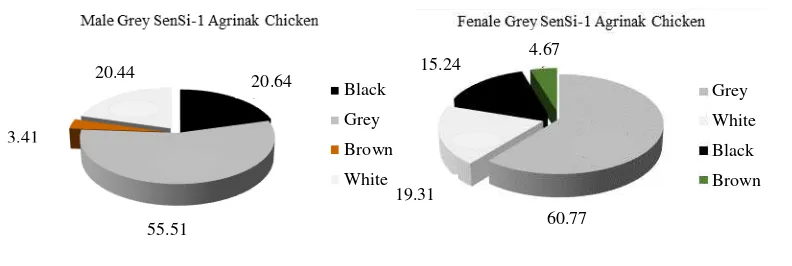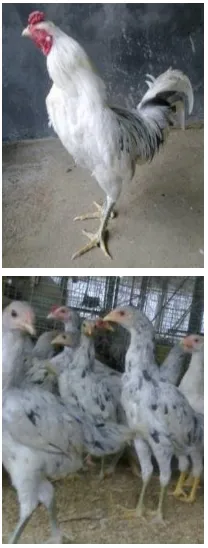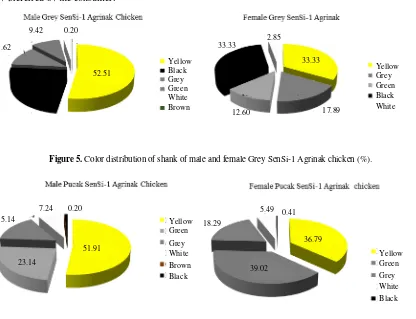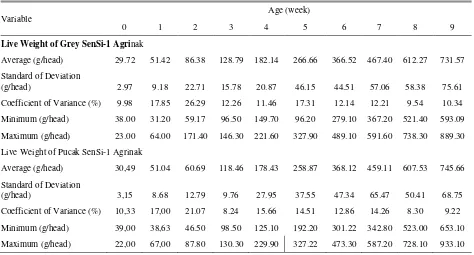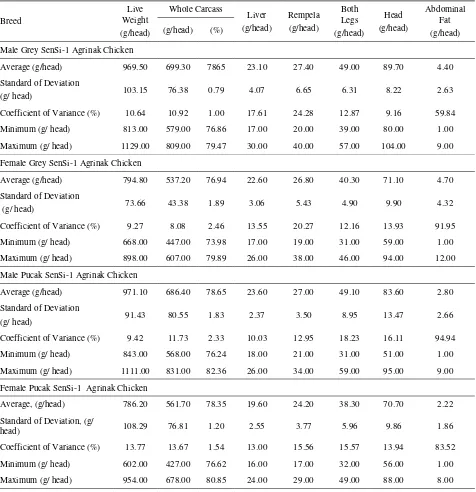Qualitative and Quantitative Characteristics of Sensi-1 Agrinak Chicken
Hasnelly, Iskandar S, Sartika T
Indonesian Research Institute for Animal Production, PO Box 221, Ciawi, Bogor E-mail: [email protected]
(received 05-04-2017; revised 14-06-2017; accepted 20-06-2017) ABSTRAK
Hasnelly, Iskandar S, Sartika T. 2017. Karakteristik kualitatif dan kuantitatif ayam SenSi-1 Agrinak. JITV 22(2): 68-79. DOI: http://dx.doi.org/10.14334/jitv.v22i2.1605
Salah satu galur ayam lokal pedaging yang dihasilkan Balai Penelitian Ternak (Balitnak) adalah Ayam Lokal SenSi-1 Agrinak. Galur baru ayam pedaging lokal ini telah dilepas dengan Surat Keputusan Menteri Pertanian No. 39/Kpts/PK.020/1/2017 pada tanggal 20 Januari 2017. SenSi-1 Agrinak diseleksi dari rumpun ayam lokal Sentul yang berasal dari Kabupaten Ciamis Jawa Barat. Kriteria seleksi berupa warna bulu abu polos, warna bulu pucak (putih bercak hitam) yang diaplikasikan terhadap jantan dan betinanya. Kriteria seleksi lain berupa jengger kacang (pea) dan bobot tubuh tertinggi 25% dari populasi per generasi ayam-ayam jantannya. Seleksi berlangsung selama enam generasi pada kondisi pemeliharaan intensif dengan ransum tunggal berkadar sekitar 17% protein kasar dan 2850 kkal ME/kg; kadar gizi lainnya mengikuti kadar yang disarankan untuk ayam ras White Leghorn. Pengukuran karakteristik kualitatif dan kuantitatif dilakukan pada sebanyak 499 ekor jantan dan 492 ekor betina SenSi-1 Agrinak Abu dan sebanyak 497 ekor jantan dan 492 ekor betina SenSi-1 Agrinak Pucak berumur 10-12 minggu dan 12 bulan. Hasil penelitian menunjukkan bahwa pada SenSi-1 Agrinak Abu, sebaran warna bulu abu pada jantan 55,51%, betina 60,77%; sebaran warna shank kuning jantan 52,51%, betina 33,33%; bentuk jengger kacang (pea) jantan 90.98 %, betina 89,23%. Pada SenSi-1 Agrinak Pucak, sebaran warna bulu pucak jantan 75,65%, betina 83,30%; sebaran warna shank kuning jantan 51,91%, betina 36,59%; sebaran jengger kacang jantan 91,55%, betina 92,28%. Rataan bobot badan 1 Agrinak berbulu Pucak Jantan 908,76+ 130,98 g/ekor betina 750,53+ 110,56 g/ekor. Rataan Bobot bobot badan SenSi-1 Agrinak berbulu Abu Jantan 886,38+SenSi-142,93 g/ekor betina 739,SenSi-17+ SenSi-1SenSi-18,87 g/ekor. Rataan bobot badan jantan terseleksi SenSi-1 Agrinak berbulu Pucak mencapai 1051+76g/ekor dan SenSi-1 Agrinak berbulu Abu 1015+107 g/ekor. Hasil penelitian ini dapat dijadikan sebagai dasar standarisasi ayam SenSi-1 Agrinak (Abu dan Pucak) sebagai male line ayam lokal pedaging.
Kata Kunci: Karakter, Sensi-1 Agrinak, Kualitatif, Kuantitatif
ABSTRACT
Hasnelly, Iskandar S, Sartika T. 2017. Qualitative and quantitative characteristics of SenSi-1 Agrinak chicken. JITV 22(2): 68-79. DOI: http://dx.doi.org/10.14334/jitv.v22i2.1605
One of local chicken breeds develop in Indonesian Research Institute for Animal Production (IRIAP) is local SenSi-1 Agrinak chicken. This new improved local-meat-type breed was released with Ministry Agriculture Decree Number 39/Kpts/PK.020/1/2017 on 20th January 2017. SenSi-1 Agrinak was originally selected from native Sentul chicken breed obtained from Ciamis district in West Java Province. Selection criteria were two feather colors of grey or black spotted white (pucak), which were applied to both males and females. Pea-comb type was also one criterion for males, applied at the age of 10 weeks. Live weight at the age of 10 weeks with the selection intensity of 25% was applied to each generation of males chicken. Selection proceeded for six generations. Selection program was carried out under standard feed formulae containing around 17% crude protein with 2850 kcal ME/ kg, and containing other nutrients following the ones recommended for modern chicken of White Leghorn. Observation was conducted on each of about 2000 young chickens of grey and of Pucak SenSi-1 Agrinak both males and females age of 10 and 84 weeks. Results showed that grey SenSi-1 Agrinak chicken in total population, had: i) Grey feather color distribution of 55.51% in males, and 60.77% in females; ii) Yellow shank color of 52.51% in males, and 33.33% in females; iii) Pea type comb of 90.98% in males, and 89.23% in females; iv). Ten weeks live weight of 886.38+142.93 g/bird in males, and 739.17+ 118.87 in females. Pucak SenSi-1 Agrinak chicken in total population, had: i) Pucak feather color of 75.65% in males, and 8330% in females; ii) Yellow shank color of 51.91% in males, and 36.59% in females; iii) Pea type comb of 91.55% in males, and 92.28% in females; iv) Ten weeks live weight of 908.76+ 130.98 g/bird in males, and 750.53+ 110.56 g/bird in females. Whilst for grey SenSi-1 Agrinak male chicken after selection had live weight at 10 weeks old of 1015+107 g/bird, and for Pucak SenSi-1 Agrinak male chicken was 1051+76 g/bird. This initial performance information for those two breeds of considerably improved local chicken can be used as the base of information for SenSi-1 Agrinak breed for male line of meat type of local chicken breeding.
INTRODUCTION
Indonesian native chicken apparently have species physical characteristic are grouped into at least 34 breeds or distinct groups of local chicken namely: Ayunai, Balenggek, Banten, Bangkok, Burgo, Bekisar, Cangehgar, Cemani, Ciparage, Gaok, Jepun, Kampung, Kasintu, Kedu (Black and White Kedu), Pelung, Lamba, Maleo, Melayu, Merawang, Nagrak, Nunukan, Nusa Penida, Olagan, Rintit or Walik, Sedayu, Sentul, Siem, Sumatera, Tolaki, Tukung, Wareng, Sabu, and Semau. Some of them are used for non-food purposes such as offerings for religious rituals, beauty – voice and feathers, and cock – fighting and indeed Kampung chickens are the most popular and kept almost production (dual-purpose) and unique phenotypic uniformity compared to another original and local chickens.
The Indonesian Research Institute for Animal Production (IRIAP) has created broiler native chicken through selection of the Sentul chicken since 2010. In 2016, the SenSi-1 Agrinak 6th generation chicken has produced superior breeding stock for male line of native chicken called SenSi-1 Agrinak through Decree of Minister of Agriculture of Indonesia Number 39/Kpts/PK.020/1/2017 on 20 January 2017. In the selection process, the chickens were divided into 2 groups based on their feather color: uniform grey color from the light gray to the dark grey and the Pucak feather (white feather with black spots by about 10-20%).
For the commercial scale, standardized qualitative and quantitative properties of the SenSi-1 Agrinak chicken are required. This study was conducted establish a baseline data on the characteristics of the SenSi-1 Agrinak chicken that may be used as a standard of the Sensi-1 Agrinak chicken.
MATERIALS AND METHODS
Released SenSi-1 Agrinak chicken in the 6th generation was sorted by their feather color:
1. SenSi-1 Agrinak with gray feather (499 heads male and 492 heads female)
2. SenSi-1 Agrinak with Pucak feather (497 heads male and 492 heads female)
The determination qualitative characteristic was based on the criteria described by Kusuma (2002) and Mansjoer (1981). Qualitative characteristics observed
were the color of feather, the color of shank and shape of comb at the age of 10 weeks.
The body weight at 0-9 weeks was observed through the weighing 10% of the population every month. For the purpose of selection to the market demand (700-1000 g/head), individual weighing weight was conducted at the tenth week.
The quantitative characteristics (body size) observed were: adult body weight, length of beak, width of beak, length of head, width of head, length of neck, length of back, chest circumference, length of chest, length of upper thighs, length of lower thighs, length of shank of 12 months old hens.
The data of qualitative characteristics were analyzed using relative phenotypic frequency formula (percentage), while the data of quantitative characteristics were analyzed by simple descriptive statistics (average, maximum, minimum, standard deviation, coefficient of variant).
RESULTS AND DISCUSSION
Qualitative characteristics
Figure 1. Color distribution of feather of male and female Grey SenSi-1 Agrinak chicken (%).
Figure 2. Grey SenSi-1 Agrinak chicken
The selected SenSi-1 Agrinak chickens were divided into two groups based on the color of feather: grey feather as Grey SenSi-1 Agrinak chicken and the white feather with blcak dots by 10-20% as Pucak SenSi-1 Agrinak chicken. Analysis results and the color of feather of SenSi-1 Agrinak chicken (Grey and Pucak) based on sex observed at 10 weeks old is presented in Figures 1-4.
Figure 1 shows that from 499 chickens observed, there are four feather colors of male Grey SenSi-1 Agrinak chickens: grey, black, golden brown and white with the percentage of 55.51%; 20.64%; 3.41% and 20.44% respectively. Meanwhile, from the 492
chickens observed in female Grey SenSi-1 Agrinak chicken, there are also four feather colors grey, black, golden brown and white with the percentage of 60.77%; 15.24%; 4.67% and 19.31% respectively.
The appearance of the four colors of feather in the Grey SenSi-1 Agrinak chicken is caused by certain pigments during their growth process. The pigments contained in the feather are lipoxrome and melanin (Natawiharja 2003). The golden old color of feather (s) is recessive to the silver color (S), plain feather (b) is recessive to the patterned feather (B). The S and s genes are adrift on the sex chromosome, as well as the B and b gens (Hutt 1949).
3.41
20.44
20.64
55.51
15.24 4.67
60.77 19.31
Black
Grey
Brown
White
Grey
White
Black
Figure 3. Color distribution of feather of male and female Pucak SenSi-1 Agrinak chicken (%).
Figure 4. Pucak SenSi-1 Agrinak Chicken.
Color of shank
Observation of the shank color was also performed at the 10 weeks old. Observation results of the color shank of the Grey and Pucak SenSi-1 Agrinak chicken based on sex are presented in Figure 5 and Figure 6.
Figure 5 shows that shank color from 499 male Grey SenSi-1 Agrinak chickens is yellow, black, green, grey, white and brown with the percentage of 52.51%; 24.05%; 9.42%; 15.14%; 7.24%; and 2.20% respectively. The shank color of 492 female grey SenSi-1 Agrinak chicken is yellow: 33.33%, black: 33.33%, grey: 17.89%, green: 12.60% and white: 2.85%.
Figure 6 shows that shank color of 497 male Pucak SenSi-1 Agrinak is yellow: 51.91%, green: 24.14%, grey: 15.14%, white: 7.24% and black: 0.20%. Then, from 492 female Pucak SenSi-1 Agrinak chickens, there are five shank colors: yellow: 36.79%, green: 39.02%, grey: 18.29%, white: 5.49%, and black: 0.41%.
The distribution of shank color of Grey and Pucak SenSi-1 Agrinak chickens both in the male and female was still varied (yellow, grey, black, green, brown and white). The large variation of shank color of the Grey and Pucak SenSi-1 Agrinak chicken has the great similarities with the most shank of the native chickens.
As the percentage of shank color distribution showedthat the yellow color was dominant. Yellow 24.35
White
Grey
White
Grey
Brown
75.65
16.30 0.40
shank in the American chicken and other breed is formed by fat or lipoxrom pigment in the epididymis layer and no melanin pigment in the epididymis and dermis layers. Melanin gen in the dermis layer is recessive (id) to the melanin pigmentation inhibitor gen, lipoxcrom (Id). The existence of the gen B in chicken may decrease the number of melanin pigment in the shank.
The yellow color of the shank of female chicken may be used to estimate egg production rate by looking at color change of shank. The lipoxcrop pigment in the shank is identical with the yellow pigment in the egg. So that, the shank color may be used as an indication of egg production rate of a chicken. Therefore, the shank color change may be used for layer chicken culling (Jull 1951).
The meat color of the Grey and Pucak SenSi-2 Agrinak chicken was dominant light. Skin meat color is closely related to the meat color. The light color of the Grey and Pucak SenSi-1 Agrinak chicken meat is mostly preferred by the consumer.
Comb type Agrinak chicken in this study.
Figure 7 shows the variance of the comb type of male Grey SenSi-1 Agrinak chicken 90.98% of pea and 9.02% of scomb. Whereas, in the female grey SenSi-1 Agrinak chicken, the pea type is 89.23%, and the scomb type is 10.77%. Figure 8 shows the dominant comb type of male Pucak SenSi-1 Agrinak chicken is the pea type of 91.55% with the recessive one is scomb of 8.45%. Whereas, the dominant comb type of the female Pucak SenSi-1 Agrinak chicken is the pea type as well of 92.28%, and 7.72% is the scomb type as the recessive
Figure 5. Color distribution of shank of male and female Grey SenSi-1 Agrinak chicken (%).
Figure 7. Distribution of comb type of the male and female Grey Sensi-1Agrinak chicken.
Figure 8. Distribution of comb type of the male and female Pucak Sensi-1Agrinak chicke
n.
Quantitative characteristics
Body weight at 0-9 weeks old
Average live weight at 0-9 weeks old is presented in Table 1, and based on the sex in Table 2.
The live weight observation was conducted for 10% of total population. Table 1 shows a normal growth performance indicated by the increase of live weight along with the age. The average live weight of Pucak SenSi-1 Agrinak chicken was higher of 745.66±68.75 g/head than the Grey SenSi-1 Agrinak chicken of 731.57±75.61 g/head.
High value of the coefficient of variance of the Grey SenSi-1 Agrinak chicken indicating the absence of uniformity on the growth in the population. Different from Grey SenSi-1 Agrinak chicken, the coefficient of variance value of Pucak Sensi-1 Agrinak (fewer than
15%) shows that uniformity on the growth of the male and female SenSi-1 Agrinak chicken appeared at 10 weeks old is uniform. Nasoetion (1992) said that uniform livestock animal population has coefficient of variance value of 5-15%. Then, Sidadolog (2011) suggested that common coefficient variance of native chicken is 25%. The body weight of Grey and Pucak SenSi-1 Agrinak chicken as the male line at the 6th generation is presented in Table 3.
Table 3 shows that the average live weight of selected male at 10 weeks old based on feather color variance was >1 kg. The average live weight of Pucak SenSi-1 Agrinak was 1051±107g/head from 103 head chicken, while the average live weight of Grey SenSi-1 Agrinak chicken was 1015±76g/head from the same number population with a coefficient of a variant of 7.22%-10.58%.
9.02%
90.98%
10.77%
89.23%
91.55%
8.45% 7.72%
Table 1. Live weight of Grey and Pucak SenSi-1 Agrinak chicken at 0-9 weeks old
Variable Age (week)
0 1 2 3 4 5 6 7 8 9
Live Weight of Grey SenSi-1 Agrinak
Average (g/head) 29.72 51.42 86.38 128.79 182.14 266.66 366.52 467.40 612.27 731.57
Standard of Deviation
(g/head) 2.97 9.18 22.71 15.78 20.87 46.15 44.51 57.06 58.38 75.61
Coefficient of Variance (%) 9.98 17.85 26.29 12.26 11.46 17.31 12.14 12.21 9.54 10.34
Minimum (g/head) 38.00 31.20 59.17 96.50 149.70 96.20 279.10 367.20 521.40 593.09
Maximum (g/head) 23.00 64.00 171.40 146.30 221.60 327.90 489.10 591.60 738.30 889.30
Live Weight of Pucak SenSi-1 Agrinak
Average (g/head) 30,49 51.04 60.69 118.46 178.43 258.87 368.12 459.11 607.53 745.66
Standard of Deviation
(g/head) 3,15 8.68 12.79 9.76 27.95 37.55 47.34 65.47 50.41 68.75
Coefficient of Variance (%) 10,33 17,00 21.07 8.24 15.66 14.51 12.86 14.26 8.30 9.22
Minimum (g/head) 39,00 38,63 46.50 98.50 125.10 192.20 301.22 342.80 523.00 653.10
Maximum (g/head) 22,00 67,00 87.80 130.30 229.90 327.22 473.30 587.20 728.10 933.10
Table 2. Live weight of Grey and Pucak SenSi-1 Agrinak chicken at 10 weeks old
Variable Male Female
Grey SenSi-1 Agrinak Chicken
Population, (head) 499 492
Live Weight
Average (g/head) 886.38 739.17
Standard of Deviation, (g/ head) 142.93 118.81
Coefficient of Variance (%) 16.12 16.07
Minimum (g/ head) 323.00 339.00
Maximum (g/ head) 1330.00 1075.00
Pucak SenSi-1 Agrinak Chicken
Population (head) 497 492
Live Weight
Average, (g/ head) 908.76 750.53
Standard of Deviation, (g/ head) 130.98 110.56
Coefficient of Variance, (%) 14.41 14.73
Minimum, (g/ head) 515.00 323.00
Maximum, (g/ head) 1251.00 1088.00
Feed consumption increasing with increasing age and body weight. Both
As consequence, the body weight will highly be influenced by feed consumption. Until 10 weeks old, the Grey and Pucak SenSi-1 Agrinak chickens consumed similar diet by 70.99 gr/head and 78.31 g/head respectively. Cumulatively, the average amount of diet consumed until 10 weeks old of Grey and Pucak SenSi-1 Agrinak chicken was ± 2.5 kg/head.
Carcass
The carcass is a crucial factor in assessing meat
production as an edible body part (Moran 1977). The
carcass of the broiler chicken is part of live broiler chicken after slaughtered, and removal of the feather,
viscera, abdominal fat, head, neck and the both legs. Table 5 shows carcass quality of Grey and Pucak SenSi-1 Agrinak chickens.
Average carcass weight of the Grey and Pucak SenSi-1 Agrinak both male and female was quite high by 75%. This percentage is higher than the carcass percentage of crossed KUB with Sentul and Gaok chickens by 64.10-66.73% (Hasnelly 2013). Hasnelly (2013) stated that carcass production may be determined from cutting weight. The heavier cutting weight produces higher carcass. The common color of carcass of Grey and Pucak SenSi-1 Agrinak is yellowish white, besides gray carcass, especially of the grey SenSi-1 Agrinak chicken
Table 3. Live weight of selected male SenSi-1 Agrinak chicken at 10 weeks old
Variables Grey SenSi-1 Agrinak Pucak SenSi-1 Agrinak
Population, (head) 103 103
Live Weight
Average (g/head) 1015 1051
Standard of Deviation (g/ head) 107 76
Coefficient of Variance (%) 10.58 7.22
Minimum (g/ head) 1330 1251
Maximum (g/ head) 839 903
Table 4. Feed consumption of Grey and Pucak SenSi-1 Agrinak at 0-10 weeks old
Variables Age (week)
1 2 3 4 5 6 7 8 9 10
Feed consumption of Grey SenSi-1 Agrinak
Average (g/head) 6.65 11.09 17.30 22.48 26.89 37.69 62.49 59.87 67.30 70.99
Standard of Deviation
(g/ head) 0.95 1.32 1.95 6.98 6.79 4.22 14.51 12.53 15.38 21.16
Coefficient of Variance (%) 14.22 11.91 11.26 31.05 25.27 11.19 23.23 20.93 22.85 29.81
Minimum (g/ head) 5.24 9.16 15.01 18.78 20.03 3194 40.16 42.55 51.26 51.01
Maximum (g/ head) 11.90 13.83 27.74 68.77 45.52 46.87 98.78 99.71 112.20 118.43
Feed consumption of Pucak SenSi-1 Agrinak
Average (g/head) 6.93 11.38 17.79 21.49 29.63 41.12 60.88 66.09 70.79 78.31
Standard of Deviation
(g/ head) 0.39 1.72 2.16 6.75 8.31 8.53 17.41 13.77 19.28 17.28
Coefficient of Variance (%) 5.62 15.08 12.13 31.43 28.06 20.73 28.60 20.83 27.24 22.07
Minimum (g/ head) 5.89 9.37 15.33 18.21 19.19 31.40 37.29 51.97 55.63 51.01
Table 5. Carcass and carcass pieces of SenSi-1 Agrinak chicken at 10 weeks old
Breed
Live Weight
(g/head)
Whole Carcass
Liver (g/head)
Rempela (g/head)
Both Legs
(g/head)
Head (g/head)
Abdominal Fat
(g/head) (g/head) (%)
Male Grey SenSi-1 Agrinak Chicken
Average (g/head) 969.50 699.30 7865 23.10 27.40 49.00 89.70 4.40
Standard of Deviation
(g/ head) 103.15 76.38 0.79 4.07 6.65 6.31 8.22 2.63
Coefficient of Variance (%) 10.64 10.92 1.00 17.61 24.28 12.87 9.16 59.84
Minimum (g/ head) 813.00 579.00 76.86 17.00 20.00 39.00 80.00 1.00
Maximum (g/ head) 1129.00 809.00 79.47 30.00 40.00 57.00 104.00 9.00
Female Grey SenSi-1 Agrinak Chicken
Average (g/head) 794.80 537.20 76.94 22.60 26.80 40.30 71.10 4.70
Standard of Deviation
(g/ head) 73.66 43.38 1.89 3.06 5.43 4.90 9.90 4.32
Coefficient of Variance (%) 9.27 8.08 2.46 13.55 20.27 12.16 13.93 91.95
Minimum (g/ head) 668.00 447.00 73.98 17.00 19.00 31.00 59.00 1.00
Maximum (g/ head) 898.00 607.00 79.89 26.00 38.00 46.00 94.00 12.00
Male Pucak SenSi-1 Agrinak Chicken
Average (g/head) 971.10 686.40 78.65 23.60 27.00 49.10 83.60 2.80
Standard of Deviation
(g/ head) 91.43 80.55 1.83 2.37 3.50 8.95 13.47 2.66
Coefficient of Variance (%) 9.42 11.73 2.33 10.03 12.95 18.23 16.11 94.94
Minimum (g/ head) 843.00 568.00 76.24 18.00 21.00 31.00 51.00 1.00
Maximum (g/ head) 1111.00 831.00 82.36 26.00 34.00 59.00 95.00 9.00
Female Pucak SenSi-1 Agrinak Chicken
Average, (g/head) 786.20 561.70 78.35 19.60 24.20 38.30 70.70 2.22
Standard of Deviation, (g/
head) 108.29 76.81 1.20 2.55 3.77 5.96 9.86 1.86
Coefficient of Variance (%) 13.77 13.67 1.54 13.00 15.56 15.57 13.94 83.52
Minimum (g/ head) 602.00 427.00 76.62 16.00 17.00 32.00 56.00 1.00
Maximum (g/ head) 954.00 678.00 80.85 24.00 29.00 49.00 88.00 8.00
Table 6. Body weight and size of adult Grey and Pucak SenSi-1 Agrinak chicken
Variable
Male (N=25 head)
Female (N=25 head)
Maxim Minim Average StDev CoVar
(%) Maxim Minim Average StDev
CoVar (%)
Grey SenSi-1 Agrinak Chicken
Live weight (g) 3706.00 2466.00 3050.17 323.21 10.60 2623.00 1560.00 2032.48 252.34 12.42
Beak length (cm) 37.34 16.41 28.01 5.22 18.62 34.89 21.01 30.78 3.76 12.23
Beak width (cm) 15.76 9.36 12.82 1.86 14.55 19.51 10.89 16.23 3.01 18.54
Head length (cm) 57.45 36.23 48.26 5.43 11.25 51.87 34.63 45.28 3.86 8.53
Head width (cm) 39.52 24.92 32.91 3.01 9.14 34.09 27.56 31.64 1.38 4.35
Neck length (cm) 18.00 13.00 16.04 1.49 9.26 13.50 11.00 12.50 0.60 4.76
Back length(cm) 35.00 21.00 24.19 2.90 11.98 25.00 21.00 22.58 1.04 4.60
Chest circumference (cm) 43.00 33.00 38.92 2.63 6.75 36.00 28.50 32.20 1.69 5.25
Chest length (cm) 19.00 13.00 14.76 1.51 10.22 19.00 16.00 17.78 0.87 4.88
Upper thighs length (cm) 14.00 11.00 12.56 0.96 7.65 12.00 8.00 10.24 0.83 8.11
Lower thighs length (cm) 17.00 13.00 14.34 1.21 8.46 13.00 11.00 12.08 0.62 5.16
Shank length (cm) 14.00 9.00 10.68 1.03 9.64 9.00 7.00 7.94 0.55 6.88
Pucak SenSi-1 Agrinak Chicken
Live weight (g) 3808.00 2764.00 3190.80 219.53 6.88 2631.00 1538.00 2200.04 254.80 11.58
Beak length (cm) 42.35 30.84 36.97 2.76 7.47 35.52 23.46 29.27 3.00 10.27
Beak width (cm) 20.54 13.77 17.55 1.56 8.88 14.76 10.07 11.72 1.25 10.64
Head length (cm) 58.21 46.26 51.72 2.98 5.76 45.91 31.07 40.44 3.90 9.65
Head width (cm) 41.39 32.67 36.21 2.35 6.49 33.44 23.08 28.11 2.10 7.48
Neck length, (cm) 17.50 14.00 15.58 0.96 6.19 14.00 11.00 12.92 0.86 6.67
Back length (cm) 29.50 25.00 26.94 1.38 5.12 23.00 16.00 19.88 1.94 9.78
Chest circumference (cm) 41.00 35.00 37.12 1.58 4.26 37.00 28.00 33.92 2.08 6.13
Chest length (cm) 27.00 20.00 22.66 1.50 6.61 17.00 12.00 15.32 1.35 8.78
Upper thighs length (cm) 14.00 12.00 12.80 0.61 4.78 14.00 10.00 11.08 0.76 6.85
Lower thighs length (cm) 17.50 14.00 15.28 0.87 5.67 14.00 11.00 12.48 0.77 6.17
Shank length (cm) 15.00 9.50 10.88 1.08 9.95 9.00 7.00 7.96 0.35 4.41
Body size
Body size observation was conducted at 12 months of age (adult) as a consideration that there is no change in body size of the adult. The body size also describes the uniqueness of the SenSi-1 Agrinak chicken as male line of native broiler chicken. Table 6 presents adult body weight and body size of Grey and Pucak SenSi-1 Agrinak chickens both the male and female.
g/head/generation and in the Pucak SenSi-1 Agrinak chicken of 30.23 g/head/generation, or 40.94 g/head/generation. However, the actual and real selection response was higher by 43.50 g/head/generation or 55.33 g/head/generation and 38.50 g/head/generation or 47.67 g/head/generation (Iskandar et al. 2015)
Body size of adult Grey and Pucak SenSi-1 Agrinak chicken may become unique characteristics of SenSi-1 Agrinak chicken. The body firm may also vary as an unique Sentul chicken will be appeared. The body size, in many ways, is specific. This size will form a unique stereotype of the Sentul chicken. Starting from the shape of head, the shape of body and leg, harmoniously will deliver a specific impression (Sartika et al. 2007). Change of body weight shows body development of the young chicken, while the change of body size shows the growth and development of body parts (Sasimowski 1987). The average bone development increases at 4-12 weeks of age and decreases at 12-20 weeks of age. There are only a few changes of bone in the adult bird, so the measurement of bone to determine body size at the adult age gives the more accurate results (Hutt, 1949). Therefore, the body size may be used to observe quantitative characteristics of chicken.
CONCLUSION
Grey SenSi-1 Agrinak chicken had dark to light grey color of feather, while the Pucak SenSi-1 Agrinak chicken had white feather with black dots by 10-20%. The SenSi-1 Agrinak chicken also had dominant pea comb type and dominant yellow shank. The body weight of selected male SenSi-1 Agrinak chicken at 10 weeks might reach 1.015-1.051 kg/head. The body weight and size of adult male and female SenSi-1 Agrinak chickens was uniform with average coefficient of variance was lower than 15%.
REFERENCES
Agriflo. 2013. Ayam kampung. Cimanggis (Depok): Penerbit Penebar Swadaya,
Han J. 2014. Origin and evolution of molecular diversity of indigenous animal genetic resources. Proceedign AAAP
Hardjosubroto W. 2002. Aplikasi pemuliaan ternak di lapangan. Jakarta (Indones): Grasindo.
Hasnelly Z. 2013. Karakteristik karkas dan preferensi konsumen terhadap daging ayam lokal hasil persilangan. Seminar Nasional Kemandirian Pangan. UNPAD, Jatinangor
Hasnelly Z, Lia S, Ulfha. 2006.Performans ayam Merawang jantan dewasa berdasarkan karakter kualitatif dan ukuran tubuh sebagai bibit.Prosiding Seminar Nasional PATPI. Yogyakarta (Indones).
Henuk YL, Bailey CA. 2014. Husbandry systems for native chickens in Indonesia. Proceedings of The 16th AAAP Animal Science Congress. Yogyakarta (Indones): University of Gadjah Mada. p. 759-762.
Hutt FB. 1949. Genetics of the Fowl. New York (USA): McGraw-Hill Book Campany Inc.
Jull MA. 1951. Poultry husbandry, 3nd ed. New York (USA): McGraw-Hill Book Inc. p. 34-35.
Iskandar S, Sartika T. 2015. Selection for 10 weeks old body-weight on Sentul chicken. Proceedings of the 6th ISTAP, International Seminar on Topical Animal Production. Yogyakarta (Indones): Faculty of Animal Science, Universitas Gadjah Mada. p. 387-390.
Iskandar S, Sartika T, Hasnelly Z, Gunawan B. 2016. Naskah ilmiah pelepasan galur ayam lokal pedaging Sensi abu dan Sensi putih. Bogor (Indones): Balai Penelitian Ternak.
Kusuma AS. 2002. Karakteristik sifat kuantitatif dan kualitatif ayam Merawang dan ayam Kampung umur 5-12 Minggu. Skripsi Fakultas Peternakan IPB, Bogor. 17-19.
Mansjoer SS.1981. Studi sifat-sifat ekonomis yang menurun pada ayam kampung. Laporan Penelitian No 15/ Penelitian/PUT/IPB/1979-1980. Bogor (Indones): Fakultas Peternakan. Institut Pertanian Bogor.
Moran ET. 1977. Growth and meat yield in poultry. In: Boorman KN, Wilson BJ, editors. Growth and Poultry Meat Production. Edinburgh (UK): British Poultry Science Ltd. p. 145-173.
Sartika T, Iskandar S. 2007. Mengenal plasma nutfah ayam indonesia dan pemanfaatannya. 1st ed. Bogor (Indones): Balai Penelitian Ternak.
Sasimowski. 1987. Animal breeding and production an outline. Warszawa (Switzerland): PWN-Publish Scientific Publishers.
Sidadolog JHP. 2011. Pemuliaan sebagai sarana pelestarian dan pengembangan ayam lokal. Pidato Pengukuhan Jabatan Guru Besar pada Fakultas Peternakan Universitas Gadjah Mada. Yogyakarta (Indones): Universitas Gadjah Mada.
Sulandari S, Zein MSA, Paryanti S, Sartika T, Sidadolog JHP, Astuti M, Widjastuti T, Sujana E, Darana S, Setiawan I, Garnida D, Iskandar S, Zainuddin D, Herwati T, Wibawan IWT. 2007. Keanekaragaman sumber hayati ayam lokal Indonesia: Manfaat dan potensi. Bogor (Indones): Pusat Penelitian Biologi LIPI.
Munggaran, Deden K. 2004. Identifikasi sifat-sifat kuantitatif dan ukuran-ukuran tubuh pada ayam Sentul umur dewasa (Skripsi). [Bandung (Indones)]: Fakultas Peternakan, Universitas Padjadjaran.
Nasoetion AH. 1992. Panduan berfikir dan meneliti secara ilmiah bagi remaja. Jakarta (Indones): Gramedia.
